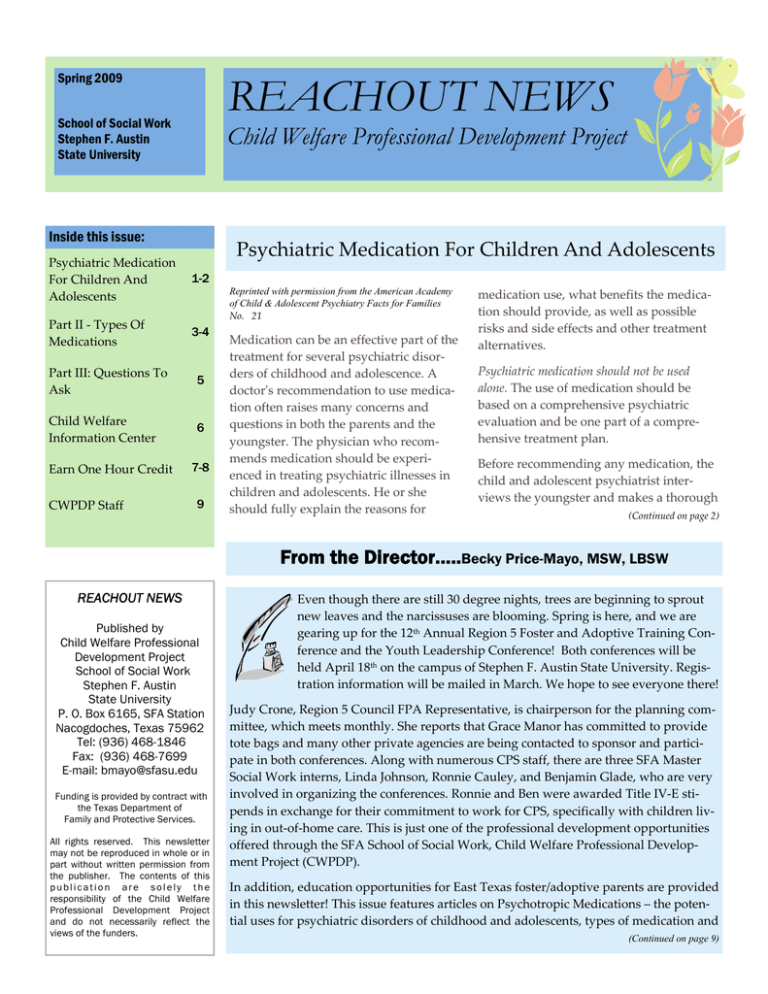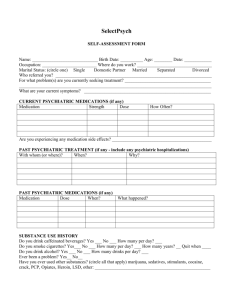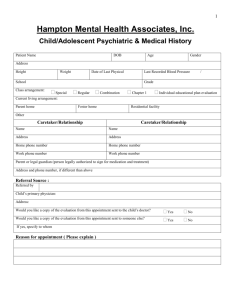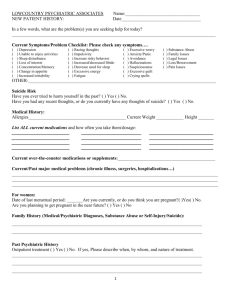
Spring 2009
REACHOUT NEWS
School of Social Work
Stephen F. Austin
State University
Child Welfare Professional Development Project
Inside this issue:
Psychiatric Medication For Children And Adolescents Psychiatric Medication For Children And Adolescents 1-2
Part II ‐ Types Of Medications 3-4
Reprinted with permission from the American Academy
of Child & Adolescent Psychiatry Facts for Families
No. 21 Part III: Questions To Ask 5
Child Welfare Information Center 6
Earn One Hour Credit CWPDP Staff 7-8
9
Medication can be an effective part of the treatment for several psychiatric disor‐
ders of childhood and adolescence. A doctorʹs recommendation to use medica‐
tion often raises many concerns and questions in both the parents and the youngster. The physician who recom‐
mends medication should be experi‐
enced in treating psychiatric illnesses in children and adolescents. He or she should fully explain the reasons for medication use, what benefits the medica‐
tion should provide, as well as possible risks and side effects and other treatment alternatives. Psychiatric medication should not be used alone. The use of medication should be based on a comprehensive psychiatric evaluation and be one part of a compre‐
hensive treatment plan. Before recommending any medication, the child and adolescent psychiatrist inter‐
views the youngster and makes a thorough (Continued on page 2) From the Director…..Becky Price-Mayo, MSW, LBSW
REACHOUT NEWS
Published by
Child Welfare Professional
Development Project
School of Social Work
Stephen F. Austin
State University
P. O. Box 6165, SFA Station
Nacogdoches, Texas 75962
Tel: (936) 468-1846
Fax: (936) 468-7699
E-mail: bmayo@sfasu.edu
Funding is provided by contract with
the Texas Department of
Family and Protective Services.
All rights reserved. This newsletter
may not be reproduced in whole or in
part without written permission from
the publisher. The contents of this
publication are solely the
responsibility of the Child Welfare
Professional Development Project
and do not necessarily reflect the
views of the funders.
Even though there are still 30 degree nights, trees are beginning to sprout new leaves and the narcissuses are blooming. Spring is here, and we are gearing up for the 12th Annual Region 5 Foster and Adoptive Training Con‐
ference and the Youth Leadership Conference! Both conferences will be held April 18th on the campus of Stephen F. Austin State University. Regis‐
tration information will be mailed in March. We hope to see everyone there! Judy Crone, Region 5 Council FPA Representative, is chairperson for the planning com‐
mittee, which meets monthly. She reports that Grace Manor has committed to provide tote bags and many other private agencies are being contacted to sponsor and partici‐
pate in both conferences. Along with numerous CPS staff, there are three SFA Master Social Work interns, Linda Johnson, Ronnie Cauley, and Benjamin Glade, who are very involved in organizing the conferences. Ronnie and Ben were awarded Title IV‐E sti‐
pends in exchange for their commitment to work for CPS, specifically with children liv‐
ing in out‐of‐home care. This is just one of the professional development opportunities offered through the SFA School of Social Work, Child Welfare Professional Develop‐
ment Project (CWPDP). In addition, education opportunities for East Texas foster/adoptive parents are provided in this newsletter! This issue features articles on Psychotropic Medications – the poten‐
tial uses for psychiatric disorders of childhood and adolescents, types of medication and (Continued on page 9)
Page 2
REACHOUT NEWS
Psychiatric Medication For Children And Adolescents Continued (Continued from page 1)
Depression‐lasting feelings of sadness, helplessness, hopelessness, unworthiness and guilt, inability to feel pleasure, a decline in school work and changes in sleeping and eating habits. Eating disorder‐either self‐starvation (anorexia ner‐
vosa) or binge eating and vomiting (bulimia), or a combination of the two. Bipolar (manic‐depressive) disorder‐periods of de‐
pression alternating with manic periods, which may include irritability, ʺhighʺ or happy mood, excessive energy, behavior problems, staying up late at night, and grand plans. Psychosis‐symptoms include irrational beliefs, para‐
noia, hallucinations (seeing things or hearing sounds that donʹt exist) social withdrawal, clinging, strange behavior, extreme stubbornness, persistent rituals, and deterioration of personal habits. May be seen in devel‐
opmental disorders, severe depression, schizoaffective disorder, schizophrenia, and some forms of substance abuse. Autism‐(or other pervasive developmental disorder such as Aspergerʹs Syndrome)‐characterized by severe deficits in social interactions, language, and/or think‐
ing or ability to learn, and usually diagnosed in early childhood. Severe aggression‐which may include assaultiveness, excessive property damage, or prolonged self‐abuse, such as head‐banging or cutting. diagnostic evaluation. In some cases, the evaluation may include a physical exam, psychological testing, laboratory tests, other medical tests such as an electro‐
cardiogram (EKG) or electroencephalogram (EEG), and consultation with other medical specialists. Medications which have beneficial effects may also have side effects, ranging from just annoying to very serious. As each youngster is different and may have individual reactions to medication, close contact with the treating physician is recommended. Do not stop or change a medication without speaking to the doctor. Psychiatric medication should be used as part of a com‐
prehensive plan of treatment, with ongoing medical as‐
sessment and, in most cases, individual and/or family psy‐
chotherapy. When prescribed appropriately by a psychiatrist (preferably a child and adolescent psychiatrist), and taken as prescribed, medication may reduce or elimi‐
nate troubling symptoms and improve the daily func‐
tioning of children and adolescents with psychiatric disorders. Medication may be prescribed for psychiatric symp‐
toms and disorders, including, but not limited to: Bedwetting‐if it persists regularly after age 5 and causes serious problems in low self‐esteem and social interaction. Anxiety (school refusal, phobias, separation or social fears, generalized anxiety, or posttraumatic stress disorders)‐if it keeps the youngster from normal daily activities. Attention deficit hyperactivity disorder (ADHD)‐
marked by a short attention span, trouble concentrat‐
ing and restlessness. The child is easily upset and frustrated, often has problems getting along with family and friends, and usually has trouble in school. Obsessive‐compulsive disorder (OCD)‐recurring obsessions (troublesome and intrusive thoughts) and/or compulsions (repetitive behaviors or rituals such as handwashing, counting, checking to see if doors are locked) which are often seen as senseless but which interfere with a youngsterʹs daily function‐
ing. Page 3
Psychiatric Medication For Children And Adolescents: Part II ‐ Types Of Medications Reprinted with permission from the American Academy of Child & Adolescent Psychiatry Facts for Families No. 29 Psychiatric medications can be an effective part of the treatment for psychiatric disorders of childhood and adolescence. In recent years there have been an increas‐
ing number of new and different psychiatric medica‐
tions used with children and adolescents. Research stud‐
ies are underway to establish more clearly which medi‐
cations are most helpful for specific disorders and pre‐
senting problems. Clinical practice and experience, as well as research studies, help physicians determine which medications are most effective for a particular child. Before recommending any medication, the psy‐
chiatrist (preferably a child and adolescent psychiatrist) should conduct a comprehensive diagnostic evaluation of the child or adolescent. Parents should be in‐
formed about known risks and/or FDA warn‐
ings before a child starts any psychiatric medica‐
tion. When prescribed appropriately by an ex‐
perienced psychiatrist (preferably a child and adolescent psychiatrist) and taken as directed, medication may reduce or eliminate troubling symp‐
toms and improve daily functioning of children and adolescents with psychiatric disorders. ADHD Medications: Stimulant and non‐stimulant medications may be helpful as part of the treatment for attention deficit hyperactive disorder (ADHD). Examples of stimulants include: •
•
Dextroamphetamine (Dexedrine, Adderal) Methylphenidate (Ritalin, Metadate, Concerta) Non‐stimulant medications include •
Atomoxetine (Strattera) matic stress disorder, and attention deficit hyperactive disorder. There are several types of antidepressant medi‐
cations. Examples of serotonin reuptake inhibitors (SRIʹs) include: •
•
•
•
•
•
•
Fluoxetine (Prozac) •
•
•
•
Bupropion (Wellbutrin) •
•
•
•
Amitriptyline (Elavil) •
•
Phenelzine (Nardil) Sertraline (Zoloft) Paroxetine (Paxil) Fluvoxamine (Luvox) Venlafaxine (Effexor) Citalopram (Celexa) Escitalopram (Lexapro) Examples of atypical antidepressants include: Nefazodone (Serzone) Trazodone (Desyrel) Mirtazapine (Remeron) Examples of tricyclic antidepressants (TCAʹs) include: Clomipramine (Anafranil) Imipramine (Tofranil) Nortriptyline (Pamelor) Examples of monoamine oxidase inhibitors (MAOIʹs) include: Tranylcypromine (Parnate) Antipsychotic Medications: These medications can be helpful in controlling psychotic symptoms (delusions, hal‐
lucinations) or disorganized thinking. These medications may also help muscle twitches (ʺticsʺ) or verbal outbursts as seen in Touretteʹs Syndrome. They are occasionally used to treat severe anxiety and may help in reducing very aggressive behavior. Examples of first generation antipsychotic medications include: Antidepressant Medications: Antidepressant medica‐
tions may be helpful in the treatment of depression, school phobias, panic attacks, and other anxiety disor‐
ders, bedwetting, eating disorders, obsessive‐
compulsive disorder, personality disorders, posttrau‐
•
•
•
Chlorpromazine (Thorazine) Thioridazine (Mellaril) Fluphenazine (Prolixin) (Continued on page 4)
Page 4
REACHOUT NEWS
Psychiatric Medication For Children And Adolescents Continued Anti‐anxiety Medications: These medications may be helpful in the treatment of severe anxiety. There are sev‐
eral types of anti‐anxiety medications: benzodiazepines; antihistamines; and atypicals. (Continued from page 3)
•
•
•
Trifluoperazine (Stelazine) Thiothixene (Navane) Haloperidol (Haldol) Second generation antipsychotic medications (also known as atypical or novel) include: •
•
•
•
•
•
Clozapine (Clozaril) Risperidone (Risperdal) Quetiapine (Seroquel) Examples of benzodiazepines include: •
•
•
•
Alprazolam (Xanax) lorazepam (Ativan) Diazepam (Valium) Clonazepam (Klonopin) Olanzapine (Zyprexa) Examples of antihistamines include: Ziprasidone (Geodon) •
•
Aripiprazole (Abilify) Diphenhydramine (Benadryl) Hydroxizine (Vistaril) Examples of atypical anti‐anxiety medications include: Mood Stabilizers and Anticonvulsant Medications: These medications may be helpful in treating bipolar disorder, severe mood symptoms and mood swings (manic and depressive), aggressive behavior and im‐
pulse control disorders. Examples include: •
Lithium (lithium carbonate, Eskalith) •
•
•
•
•
•
Valproic Acid (Depakote, Depakene) Carbamazepine (Tegretol) Gabapentin (Neurontin) Lamotrigine (Lamictil) Topiramate (Topamax) Oxcarbazepine (Trileptal) •
•
Buspirone (BuSpar) Zolpidem (Ambien) Sleep Medications: A variety of medications may be used for a short period to help with sleep problems. Examples include: •
•
•
•
Trazodone (Desyrel) Zolpidem (Ambien) Zaleplon (Sonata) Diphenhydramine (Benadryl) Miscellaneous Medications: Other medications are also being used to treat a variety of symptoms. For example: Conidine (Catapres) may be used to treat the severe im‐
pulsiveness in some children with ADHD and guan‐
facine (Tenex) for ʺflashbacksʺ in children with PTSD. Long‐Acting Medications: Many newer medications are taken once a day. These medications have the designa‐
tion SR (sustained release), ER or XR (extended release), CR (controlled release) or LA (long‐acting). Page 5
REACHOUT NEWS
Psychiatric Medication For Children And Adolescents Part III: Questions To Ask Reprinted with permission from the American Academy of Child & Adolescent
Psychiatry Facts for Families No. 51 •
Will a child and adolescent psychiatrist be monitor‐
ing my childʹs response to medication and make dos‐
age changes if necessary? How often will progress be checked and by whom? •
Are there any other medications or foods which my child should avoid while taking the medication? •
Are there interactions between this medication and other medications (prescription and/or over‐the‐
counter) my child is taking? •
Are there any activities that my child should avoid while taking the medication? Are any precautions recommended for other activities? •
How long will my child need to take this medica‐
tion? How will the decision be made to stop this medication? •
What do I do if a problem develops (e.g. if my child becomes ill, doses are missed, or side effects de‐
velop)? •
What is the cost of the medication (generic vs. brand name)? •
Does my childʹs school nurse need to be informed about this medication? Medication can be an important part of treatment for some psychiatric disorders in children and adoles‐
cents. Psychiatric medication should only be used as one part of a comprehensive treatment plan. Ongoing evaluation and monitoring by a physician is essential. Parents and guardians should be provided with complete information when psychiatric medication is recom‐
mended as part of their childʹs treatment plan. Children and adolescents should be included in the discussion about medications, using words they understand. By asking the following questions, children, adolescents, and their parents will gain a better understanding of psychi‐
atric medications: •
•
What is the name of the medication? Is it known by other names? What is known about its helpfulness with other chil‐
dren who have a similar condition to my child? •
How will the medication help my child? How long before I see improvement? When will it work? •
What are the side effects which commonly occur with this medication? •
•
Is this medication addictive? Can it be abused? •
Are there any laboratory tests (e.g. heart tests, blood test, etc.) which need to be done before my child be‐
gins taking the medication? Will any tests need to be done while my child is taking the medication? Treatment with psychiatric medications is a serious mat‐
ter for parents, children and adolescents. Parents should ask these questions before their child or adolescent starts taking psychiatric medications. Parents and children/
adolescents need to be fully informed about medica‐
tions. If, after asking these questions, parents still have serious questions or doubts about medication treatment, they should feel free to ask for a second opinion by a child and adolescent psychiatrist. For additional information on Facts for Families, go to the AACAP Web site at http://www.aacap.org/cs/root/facts_for_families/
facts_for_families What is the recommended dosage? How often will the medication be taken? Page 6
REACHOUT NEWS
Child Welfare Information Center
Diane Sizemore MSW Graduate Assistant Stephen F. Austin State University Fostering and adopting can be very rewarding, however it is not always easy to manage the difficult chal‐
lenges of parenting foster and adop‐
tive children. Dealing with child and adolescent psychiatric disorders can also be challenging, as can understanding the medications and other treat‐
ments. Knowing the resources available to you and your child is the first step in helping your child develop and work through his or her issues. before, so if you are still interested in these resources we can send you the new copies. “Anger Outbursts” ad‐
dresses some of the toughest child anger behavior prob‐
lems. There is no simple solution to anger, but this easy‐
to‐view interactive program will help parents identify problems and think about “out‐of‐
the‐box” solutions. “Fire‐Setting” Earn
Foster Parent gives parents a clear understanding Training Credit of four distinctly different types of fire‐setting behavior, and presents some unique and effective ways parents can respond. The Child Welfare Information Center (CWIC) has re‐
sources that will help foster/adoptive parents and children of all ages in coping with the struggles of being a foster and/or adopted child. CWIC also has several new and ex‐
citing resources that will enhance foster/adoptive parents’ parenting skills in various areas. Resources on Parenting Foster Children To assist foster/adoptive parents caring for children, “Working with Traumatized Children: A Handbook for Healing” by Kathryn Brohl is a reference for those who want to understand and compassionately work with trau‐
matized children and youth. This book explains how trau‐
matic experiences affect mind and body functioning and what caregivers can do to foster healing in traumatized children. Chapters include: “Trauma and Its Impact on Society,” “Defining Trauma, Acute Stress, and Posttrau‐
matic Stress Disorder,” “More About Trauma’s Impact on the Brain and Body,” “Understanding How Children Heal from Trauma,” and “Helping Children Become Resilient.” To add to our Foster Parent College collection, “Children with Autism” offers insight into Autism Spectrum Disorder (ASD). This DVD examines the core deficits of autism: communication, social skills, and play. Also covered are developmental delay, Functional Behavior Assessment, Asperger syndrome, and medical issues commonly experi‐
enced by children with autism. Reviews on New Resources We have received new copies of “Anger Outbursts” and “Fire‐Setting” in our Foster Parent College collection. Many foster parents had difficulty viewing these DVDs New to our Foster Parent College collection is “Kinship Care.” One out of every four children placed in foster care now lives with relatives. Kinship care can be very challenging to both the relative caregivers and the chil‐
dren – it is usually unplanned and arises out of a crisis situation requiring major adjustments in space, priori‐
ties and attitude. This DVD addresses these issues and offers many useful insights and practical steps for caring for children of relatives. Feel free to call for a complete listing of DVDs in the Foster Parent College Series. From all of us in the Child Welfare Professional Devel‐
opment Project, thanks for your patronage. Please do not hesitate to call our toll free number if you have any questions or would like to receive some of our re‐
sources. We look forward to hearing from you soon! A special toll free number . . .
(877) 886-6707
. . . is provided for CPS staff and foster and adoptive parents. CWIC
books, DVDs and videos are mailed to
your home or office, along with a
stamped envelope for easy return.
Please specify if you are interested in
receiving foster parent training hours, and a
test and evaluation will be included with the
book or video. Once completed and returned,
foster parents will receive a letter of verification
of training hours earned.
Your calls are important to us.
We look forward to hearing from you!
FOSTER PARENT TRAINING - REACHOUT Newsletter Spring 2009
Complete for one hour of training credit and return to your caseworker.
Learning Objectives •
•
•
•
The participant will recognize the importance of understanding a child’s psychiatric treatment plan.
The participant will identify psychiatric symptoms and disorders.
The participant will describe the uses of psychiatric medications.
The participant will understand the risks of psychiatric medications.
Learning Activities Activity One What should be done before a psychiatrist recommends medication for a psychiatric disorder? ___________________________________________________________________________________________________________
___________________________________________________________________________________________________________ When should parents and guardians ask questions about the prescribed medication? ___________________________________________________________________________________________________________
___________________________________________________________________________________________________________ Activity Two List and describe four psychiatric symptoms and disorders which may have medications prescribed for them: 1.__________________________________________________________________________________________________________
___________________________________________________________________________________________________________ 2.__________________________________________________________________________________________________________
___________________________________________________________________________________________________________ 3.__________________________________________________________________________________________________________
___________________________________________________________________________________________________________ 4.__________________________________________________________________________________________________________
___________________________________________________________________________________________________________ Activity Three List four types of psychiatric medications and describe their uses. 1.__________________________________________________________________________________________________________
___________________________________________________________________________________________________________ 2.__________________________________________________________________________________________________________
___________________________________________________________________________________________________________ 3.__________________________________________________________________________________________________________
___________________________________________________________________________________________________________ 4.__________________________________________________________________________________________________________
___________________________________________________________________________________________________________ Psychiatric medication should only be used as part of a comprehensive treatment plan. (Circle the best answer) True False Parent and guardians should be informed about _________________________________ and/or ______________________________________ before a child starts any psychiatric medication. Evaluation Date ____________ Trainer Child Welfare Professional Development Project, School of Social Work, SFA Name (optional)___________________________________________________________ Newsletter presentation and materials: 1. This newsletter content satisfied my expectations. ___Strongly agree ___ Agree ___Disagree ___Strongly disagree 2. The examples and activities within this newsletter helped me learn. ___Strongly agree ___ Agree ___Disagree ___Strongly disagree 3. This newsletter provides a good opportunity to receive information and training. ___Strongly agree ___ Agree ___Disagree ___Strongly disagree Course Content Application: 4. The topics presented in this newsletter will help me do my job. ___Strongly agree ___ Agree ___Disagree ___Strongly disagree 5. Reading this newsletter improved my skills and knowledge. ___Disagree ___Strongly disagree ___Strongly agree ___ Agree 6. What were two of the most useful concepts you learned? _________________________________________________________________________________________________ _________________________________________________________________________________________________ _________________________________________________________________________________________________ 7. Overall, I was satisfied with this newsletter. ___Strongly agree ___ Agree ___Disagree ___Strongly disagree Comments: ______________________________________________________________________________________________ _________________________________________________________________________________________________________ Page 9
REACHOUT NEWS
Child Welfare Professional Development Project
Director (Continued from page 1)
questions to ask the physician – from the American Acad‐
emy of Child & Adolescent Psychiatry. We hope you find this information useful in your care and supervision of foster and adopted children. Remember to complete the enclosed learning activities and evaluation and give to your case worker for ONE HOUR of foster parent train‐
ing. Often times it can be a financial challenge to obtain training. The Child Welfare Information Center also of‐
fers education opportunities for foster and adoptive par‐
ents from the convenience of their homes. Be sure to read about new DVDs and books that can be checked out for training hours (p. 6). We have added the most recent DVDs in the Foster Parent College series, which continues to be our most popular resource for parents. While Diane Sizemore, student assistant, is completing her last semester for a MSW degree, Fateemah Helaire will be returning your calls for assistance in finding the most appropriate resource for helping you parent your foster child. Tulasi Dhulipalla is also a new graduate assistant. She is from India and is studying abroad at SFA in the Kinesiology department and has plans to become a physical therapist. This spring, Tulasi will be working behind the scenes on the conference and many other CWPDP activities. Our staff encourages your feedback and recommenda‐
tions for new training topics. Feel free to call our toll free number at (877) 886‐6707 and let us know how we can support your parenting efforts. Save the Date!
12th Annual Region 5
Foster and Adoptive Training Conference
APRIL 18, 2009
Stephen F. Austin State University
Nacogdoches, Texas 75962
Peter Alsop, Ph.D.
Keynote Speaker
CEUs for LSW, LPC, TAADAC and LCDC
Foster Parent Training Hours
Conference Partners
SFA School of Social Work
Texas Department of Family and Protective Services
Region 5 Foster Parent Council
Foster and adoptive and kinship caregivers, you are the EVERYDAY HEROES! Sincerely Becky Price‐Mayo Child Welfare Professional Development Project Staff
Linda Johnson
MSW Intern
(936) 468-1846
Fateemah Helaire
Graduate Assistant
(936) 468-2705
Becky Price-Mayo, MSW, LBSW
Director
(936) 468-1808
bmayo@sfasu.edu
Tulasi Dhulipalla
Graduate Assistant
(936) 468-2228
Diane Sizemore
Student Assistant
Stephen F. Austin State University School of Social Work Child Welfare Professional Development Project P.O. Box 6165, SFA Station Nacogdoches, TX 75962‐6165 REACHOUT NEWS
Spring 2009
Earn One Hour of
Foster Parent Training
Child Welfare Professional Development Project
School of Social Work, Stephen F. Austin State University







